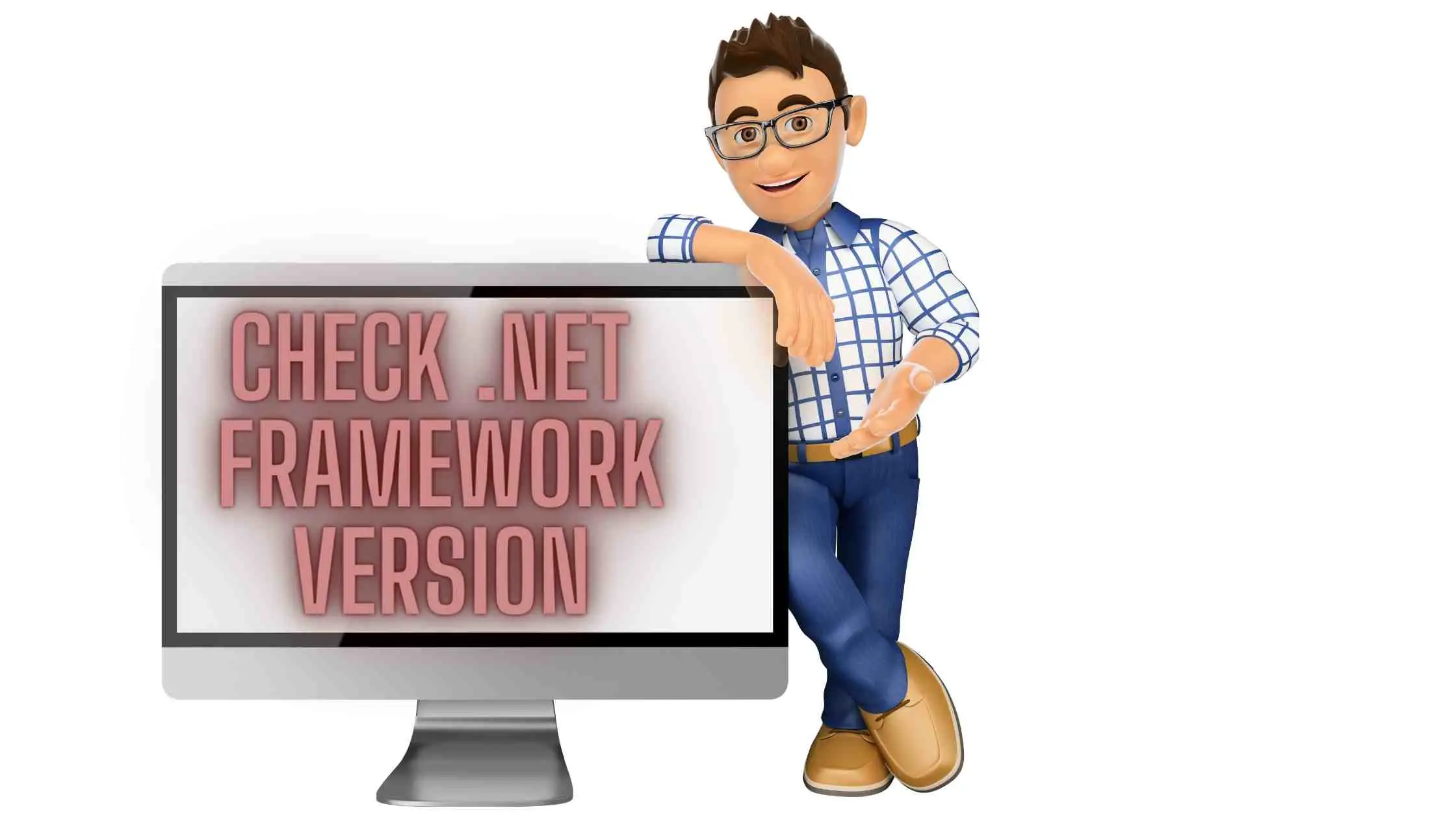Checking the .NET Framework version on your system is like finding a hidden treasure map for developers and tech enthusiasts alike. Whether you're troubleshooting an application or ensuring compatibility, knowing how to check .NET Framework version can save you a ton of time and headaches. In this article, we'll walk you through every step of the process, making it as easy as pie. So, grab your favorite drink, sit back, and let's dive in!
If you've ever wondered how to check .NET Framework version, you're not alone. Many users find themselves scratching their heads when faced with this task. But don't worry—we've got your back. By the end of this guide, you'll be a pro at identifying which versions of .NET Framework are installed on your system. It's like learning a secret code that unlocks a world of possibilities for your applications.
Before we jump into the nitty-gritty details, let's quickly understand why knowing how to check .NET Framework version matters. Imagine trying to run a program that requires .NET Framework 4.8, but your system only has version 3.5. Frustrating, right? By mastering this skill, you'll avoid compatibility issues and ensure smooth sailing for all your software needs. Now, let's get started!
- Hdhub4u Com 2024 Your Ultimate Destination For Highquality Entertainment
- Vivienne Goldstein Brett Goldstein The Untold Story Of A Hollywood Power Couple
- Neil Flynn Wife Marriage Net Worth The Truth Revealed
- Masa 49 Unveiling The Mystery Diverse Meanings Explained
- Lala Kudo The Rising Star In The Japanese Av Industry Ndash Career Facts And More
What Is .NET Framework Anyway?
Alright, let's break it down. The .NET Framework is like the backbone of Windows applications. It's a software development platform created by Microsoft that allows developers to build, deploy, and run applications. Think of it as the foundation that supports a wide range of programs, from simple desktop apps to complex web services.
Here’s why it’s important to know how to check .NET Framework version:
- It ensures compatibility with the applications you're running.
- It helps identify outdated versions that may need updates.
- It gives you peace of mind knowing your system is up to date.
So, whether you're a developer or just a curious user, understanding .NET Framework is crucial. And the first step is learning how to check .NET Framework version on your system.
- Kannada Movierulz 2023 The Ultimate Destination For Kannada Cinema Enthusiasts
- Aagmaalgive Alternatives
- Aditi Mistry Nipple Slip Details Reactions And Controversy Explained
- Movierulz 2025 Latest Movies News You Need To Know
- Animeflv Alternatives
Why You Need to Know How to Check .NET Framework Version
Let’s face it—technology moves fast. Applications evolve, and so does the .NET Framework. If you're running an older version, you might encounter issues like crashes, slow performance, or even security vulnerabilities. That's where knowing how to check .NET Framework version comes in handy.
Here are a few scenarios where checking the .NET Framework version can save the day:
- Application Compatibility: Some apps require specific versions of .NET Framework to function properly.
- Security Updates: Older versions may have vulnerabilities that need to be patched.
- System Optimization: Ensuring you have the latest version can improve overall system performance.
By mastering this skill, you'll be better equipped to handle any tech-related challenges that come your way. And trust us, it's not as complicated as it sounds!
How to Check .NET Framework Version: The Basics
Now that we know why it's important, let's dive into the methods for checking .NET Framework version. There are several ways to do this, and we’ll explore the most common ones. Don’t worry—we’ll keep it simple and straightforward.
Method 1: Checking via the Registry Editor
The Windows Registry is like a treasure chest of system information. To check .NET Framework version using the Registry Editor, follow these steps:
- Press
Win + Ron your keyboard to open the Run dialog box. - Type
regeditand hit Enter to open the Registry Editor. - Navigate to
HKEY_LOCAL_MACHINE\SOFTWARE\Microsoft\NET Framework Setup\NDP. - Here, you’ll see subkeys for each installed version of .NET Framework. Look for the latest version number.
Voilà! You’ve successfully checked the .NET Framework version using the Registry Editor. Easy, right?
Method 2: Using the Command Prompt
For those who love command-line magic, the Command Prompt is your best friend. Here's how to check .NET Framework version using this method:
- Open the Command Prompt by pressing
Win + R, typingcmd, and hitting Enter. - Type the following command and press Enter:
reg query "HKLM\SOFTWARE\Microsoft\NET Framework Setup\NDP" /s - Look for the latest version number listed in the output.
This method is quick and efficient, especially for power users who prefer the command line. Give it a try!
Advanced Techniques for Checking .NET Framework Version
For those who want to go the extra mile, there are a few advanced techniques to check .NET Framework version. These methods are ideal for developers or IT professionals who need more detailed information.
Method 3: Using PowerShell
PowerShell is a powerful tool that can make your life much easier. To check .NET Framework version using PowerShell, follow these steps:
- Open PowerShell by searching for it in the Start menu.
- Type the following command and press Enter:
Get-ChildItem 'HKLM:\SOFTWARE\Microsoft\NET Framework Setup\NDP' - Examine the output to find the latest installed version.
PowerShell is especially useful if you need to automate the process or integrate it into scripts. It's like having a superpower at your fingertips!
Method 4: Checking via System Information
If you prefer a graphical approach, the System Information tool is a great option. Here's how to use it:
- Press
Win + R, typemsinfo32, and hit Enter. - In the System Information window, scroll down to the "Components" section.
- Expand the "Internet Settings" and look for ".NET Framework" details.
This method is perfect for users who aren't comfortable with the command line or Registry Editor. Plus, it provides a wealth of other system information that might come in handy.
Common Issues and Troubleshooting
Even with the best methods, things can sometimes go wrong. Here are a few common issues you might encounter when checking .NET Framework version and how to fix them:
Issue 1: Access Denied in Registry Editor
If you receive an "Access Denied" error while trying to access the Registry Editor, it usually means you don’t have administrative privileges. To resolve this, try running the Registry Editor as an administrator:
- Right-click on the Start button and select "Run as administrator."
- Enter your administrator credentials if prompted.
- Retry accessing the .NET Framework keys.
Issue 2: Command Not Found in Command Prompt
Some users may encounter an error where the command doesn’t work as expected. This could be due to a corrupted installation or missing components. To fix this:
- Reinstall the latest version of .NET Framework from the official Microsoft website.
- Ensure your system is fully updated.
By addressing these common issues, you’ll ensure a smoother experience when checking .NET Framework version.
Understanding .NET Framework Versions
Now that you know how to check .NET Framework version, let’s talk about the different versions and what they mean. Here’s a quick breakdown:
- .NET Framework 1.0 – 3.5: These are older versions that are rarely used today. If you find them installed, consider updating to a newer version.
- .NET Framework 4.x: This is the most widely used version, offering improved performance and security features.
- .NET Core: A cross-platform successor to .NET Framework, designed for modern applications.
Understanding the differences between these versions can help you make informed decisions about which one to use for your projects.
Best Practices for Managing .NET Framework Versions
Managing .NET Framework versions is essential for maintaining a healthy system. Here are some best practices to keep in mind:
- Regularly update to the latest version for improved security and performance.
- Uninstall outdated versions if they’re no longer needed.
- Ensure your applications are compatible with the installed version.
By following these best practices, you’ll avoid common pitfalls and ensure a seamless experience with .NET Framework.
Conclusion: Mastering How to Check .NET Framework Version
We’ve covered a lot of ground in this article, from the basics of .NET Framework to advanced techniques for checking its version. By now, you should feel confident in your ability to identify which versions are installed on your system.
Remember, knowing how to check .NET Framework version is more than just a technical skill—it’s a crucial step in ensuring your system runs smoothly. Whether you’re a developer, IT professional, or casual user, mastering this skill will pay off in the long run.
So, what are you waiting for? Put your newfound knowledge to the test and start checking those .NET Framework versions! And don’t forget to share this article with your friends and colleagues. Together, we can make the tech world a better place.
Table of Contents
- What Is .NET Framework Anyway?
- Why You Need to Know How to Check .NET Framework Version
- How to Check .NET Framework Version: The Basics
- Method 1: Checking via the Registry Editor
- Method 2: Using the Command Prompt
- Advanced Techniques for Checking .NET Framework Version
- Method 3: Using PowerShell
- Method 4: Checking via System Information
- Common Issues and Troubleshooting
- Understanding .NET Framework Versions
- Best Practices for Managing .NET Framework Versions
- Conclusion: Mastering How to Check .NET Framework Version
- Pining For Kim New Animation Out Now
- Quiero Agua Video The Horrifying Truth What You Should Know
- Discover The Pepper0 Family Manga Universe
- Unleashing The Power Of Dogxxxxxx A Comprehensive Guide
- Httpsviralkandcom


